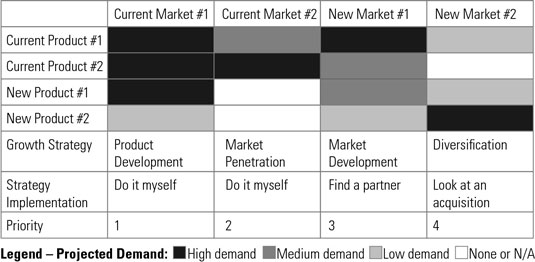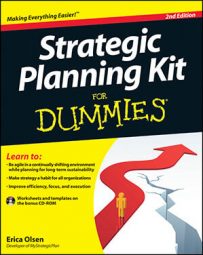After you lay out different growth strategies, you need to evaluate which path you want to take. But in order to choose a path, you must decide how to execute the strategy. By matching your growth strategies with your strengths, weaknesses, and opportunities, you can determine which ones to pursue.
The best way to visually see your strategic choices is to create a Product/Market grid. Developing this grid helps you prioritize and sort your options. The figure provides an example; use it along with the following steps to develop your grid.
Create a table that lists all your current and potential products down the left column and all your current and proposed markets across the top.
Refer to the figure for an example of the grid in action. Note how Current Market #1 and New Market #1 have the highest priority based on projected market demand.
Estimate the demand for your current and new products in each of the markets by filling in the cells different shades of gray.
For example, if the product has a potential high demand, shade the cell dark gray. If the product has a low demand, fill the cell with light gray.
Based on your demand estimations, select your growth strategy.
Look at whether you’re leveraging your product or your market knowledge in each market. For example, in the column titled Current Market #1, there’s high demand for the two current products and one new one. To increase sales for the new product, the company will continue to serve the market by executing a product development strategy.
Decide how to execute the growth strategy.
You need to base this decision on your knowledge and judgment of the resources you have to execute each strategy. Will you do it yourself, find a partner, or acquire a business?
Prioritize each group based on which is the best opportunity for your company.
Use this information to guide the development of your customer goals and objectives.

Basing your project demand on market research and past sales is the best way to construct this grid. Although this info isn’t always available, do your best to fill in the grid because it provides you with a good idea of how likely one strategy is compared to the others.
If you have the time, jump online, talk to your sales people, or hire a market research firm to get the real data to fill in your Product/Market grid.
Keep your Product/Market Grid handy. You’ll use it again to develop your goals and objectives in your strategic plan.

